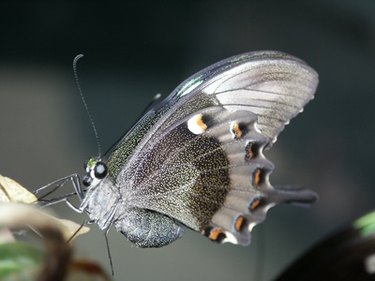
Butterflies are not usually considered pests, but certain species of swallowtails are an exception. The black swallowtail lays eggs on carrots, parsley and dill. The bright green, yellow and black caterpillars feed on the plants. Orangedog caterpillars are the larva of the giant swallowtail and feed on citrus plants. They resemble bird droppings, and can defoliate small trees and potted plants. They seldom cause enough damage to harm adult trees. Swallowtail caterpillars can extrude a gland that resembles a snake's tongue called an osmeterium. It emits a foul-smelling secretion that repels some predators.
Step 1
Pick off any caterpillars you can see. Swallowtail caterpillars are large, so you can easily spot them on smaller plants.
Video of the Day
Step 2
Apply a commercial spray or dust that contains the bacteria bacillus thuringiensis. It is fatal to caterpillars but harmless to other animals.
Step 3
Apply a chemical control agent, such as SEVIN. Be sure to read package instructions because some chemical controls can cause increases the populations of other pests.
Tip
If you want to enjoy the beautiful adult swallowtail butterflies, you can transfer the caterpillars to a designated host plant instead of killing them.
Video of the Day